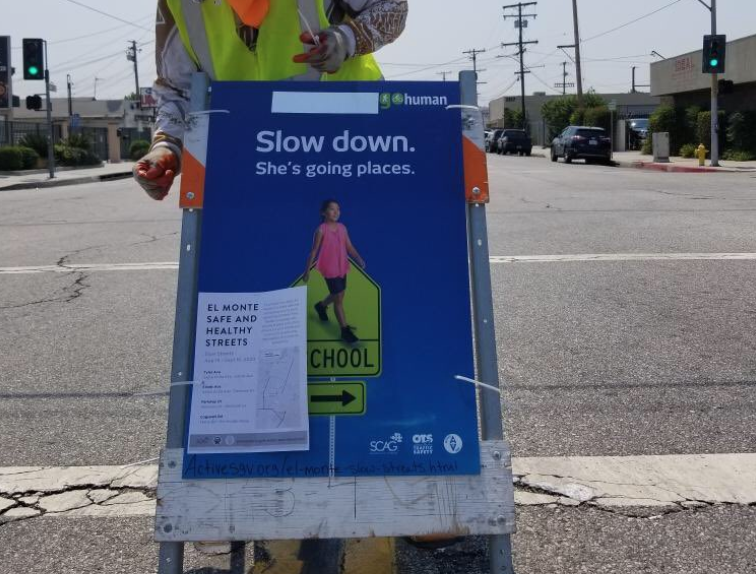Earlier this summer, the Los Angeles County Board of Supervisors voted to move forward with a "slow and safe streets" program in Los Angeles County's unincorporated communities as a joint program between the Departments of Public Health and Public Works. "Slow Streets" are re-designated public streets with limited through car traffic that create space for people choosing to walk/bike/roll for transportation and exercise during the COVID-19 pandemic.
The county's program is similar to ones already up and running in the cities of Los Angeles, Pasadena, Alhambra and several other cities throughout L.A. County. The County effort is built with 2020 Vision Zero Action Plan - which aims to eliminate traffic deaths - and its 2016 Park Needs Assessment. For more on the county's Slow Streets plan, visit their Vision Zero Website, and scroll down.
Streetsblog's Kris Fortin caught up with Supervisor Hilda Solis, who is a lead author on both the measure that created the county's program and motion at Metro to help fund slow streets programs in cities and unincorporated areas throughout the county.
Kris Fortin (KF): LA County and Metro have made decisions this week to enact Slow Streets programs in the region, and in both instances, you have been a lead sponsor on these motions. Can you explain what you’ve seen in the community to warrant this push?
Supervisor Hilda Solis (HS): Most of the unincorporated parts of my District are made up of low-income, minority communities that have little access to parks and older streets with very narrow sidewalks. It is incumbent upon us as elected officials to ensure our residents have the space they need to conduct essential activities during the pandemic without close contact with their neighbors. Walking, taking the bus, exercising, and biking are all activities that take place on our roadways, but as of now most our roads are dedicated to cars. Slow Streets will help mak e our roads safer for these essential activities.

KF: There are different types of slow street programs out in the world right now. Pasadena is encouraging drivers to slow down on residential streets, but not closing them off. Oakland used a strategy to bar specific types of traffic but allowed for slower moving vehicles like delivery and trash trucks to pass thru. There are even some programs that are trying to slow down traffic in arterial corridors, and others that are widening sidewalks. What do you hope LA County’s slow streets program will offer, but how flexible will it be to be relevant to people’s actual needs?
HS: Our program will focus on residential areas in park-poor communities. Unincorporated East Los Angeles, Walnut Park, and other communities will see Slow Streets networks that encompass between 10 and 25 intersections rather than single corridors. This network approach to Slow Streets will create safer connections to workplaces and other essential businesses. Public Works will conduct outreach to communities to promote Slow Streets, and residents also have the option of applying for Slow Streets themselves.
KF: LA County’s board of supervisors directed staff to develop design guidelines, a list of 5-10 corridors, and even made reference to the County’s vision zero plan. How will these corridors be decided as slow streets? And is the County going to invest in some corridors and leave it up to the public to design and implement what they feel is needed?
HS: Slow Streets networks will be decided upon in partnership with our communities. The County will identify networks that might be successful based on data and engage residents in that area to create a program supported by the community. Alternatively, residents can apply for Slow Streets networks themselves in areas that the County may not have identified. The County will support any Slow Street desired by the community.
KF: One thing that has been missed in figuring out how these slow street programs are implemented, is what about gang presence or activity in these areas? Walking without getting hit up or harassed is something a lot of folks take for granted, but LA County does contain these realities. I haven’t heard folks in government talking about working with gang interventionists or engaging local gang members to create safe zones for people to walk, bike or play. So, if we’re encouraging residents to come out and use space, how is this reality being considered?
HS: The issue of public safety comes up in many policy areas, and the County is trying to address this comprehensively.
In the wake of both the death of George Floyd and the on-going pandemic, one solution that I have advocated for to address public safety is establishing a Community Ambassadors program for the County. These Ambassadors can act as alternatives to law enforcement and can engage people on our roadways by offering assistance and education and connecting them with vital County resources. Ambassadors can be stewards of public land, and make our communities feel safer to be in.
Since Slow Streets are envisioned to empower local neighborhoods as a place for physical and family-oriented activity, we see it as a countermeasure and deterrent to gangs, drug use, and other illicit activities.
SGV Connect is supported by Foothill Transit, offering car-free travel throughout the San Gabriel Valley with connections to the new Gold Line Stations across the Foothills and Commuter Express lines traveling into the heart of downtown L.A. To plan your trip, visit Foothill Transit. “Foothill Transit. Going Good Places.”
Sign-up for our SGV Connect Newsletter, coming to your inbox on Fridays.







